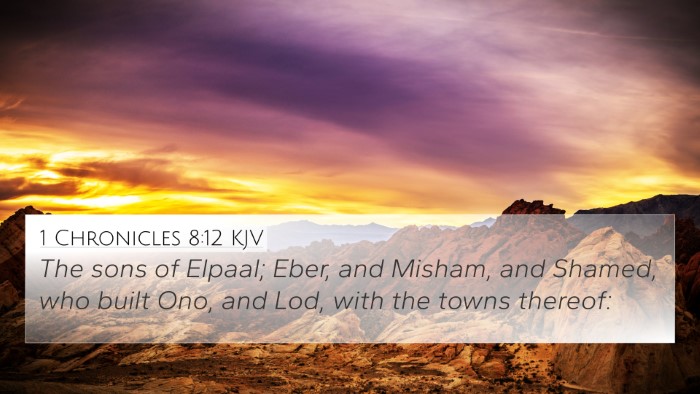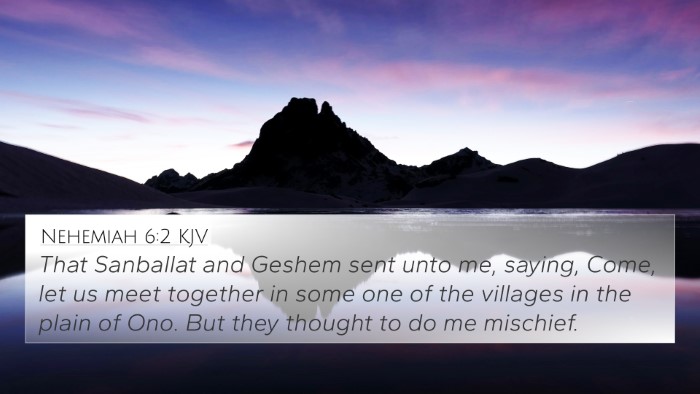Understanding Ezra 2:33
Ezra 2:33 reads: "The children of the porters: the children of Shallum, the children of Ater, the children of Tabbaoth." This verse provides a list of families returning from Babylonian exile, specifically mentioning the porters. The significance of this verse extends beyond mere enumeration; it highlights the roles and responsibilities of individuals in the restored community.
Overview of Ezra 2
This chapter of Ezra is fundamentally about the return of exiled Israelites to Jerusalem after the Babylonian captivity. It serves to document the lineage of those returning, which emphasizes their identities and the fulfillment of God's promise of restoration.
Insights from Public Domain Commentaries
Matthew Henry's Commentary: Henry notes that the mention of the porters is crucial in understanding the organization of temple worship. The porters were gatekeepers, a significant role in ensuring that the temple remained consecrated and orderly. Their inclusion in the list implies that their duties were essential for the proper functioning of the community's spiritual life.
Albert Barnes' Notes: Barnes emphasizes the fulfillment of prophecy through this return. The children of porters mentioned indicate not just a physical return to the land but a restoration of the priestly duties necessary for worship. Barnes also correlates this with the established order set by David in organizing the Levitical duties.
Adam Clarke's Commentary: Clarke adds that this verse illustrates the importance of service within the community. The porters, being a distinct group, indicate that every role, no matter how seemingly minor, contributes to the holiness of the temple and the overall community. Clarke remarks on the significant task assigned to the porters as protectors of the sacred space.
Connecting Themes and Cross-References
Understanding Ezra 2:33 can be enriched through cross-referencing with various Bible verses that relate to service, leadership, and community organization. Here are several key Bible verses that offer deeper insights:
- 1 Chronicles 9:17-19: Details the duties and roles of the gatekeepers, aligning with the porters of Ezra 2:33.
- 2 Chronicles 23:19: Mentions the porters of the temple, underscoring their ongoing importance in temple service.
- Psalms 84:10: Expresses the value of serving in the house of God, which the porters embodied through their roles.
- Matthew 5:14-16: Relates to the principle that every individual's role in the community contributes to the overall light of God’s glory.
- Hebrews 10:24-25: Encourages assembly and communal responsibilities, echoing the need for active participation in worship roles.
- Acts 6:1-7: Reflects on the division of labor within the early church, mirroring the organization seen in the Old Testament roles of servants.
- Nehemiah 11:19: Provides further insight into the roles of porters and their continuation during the rebuilding period.
- 1 Peter 2:9: Illustrates that all believers are a royal priesthood, connecting to the roles exemplified by the porters.
- Philippians 2:2: Exhorts believers to unity and service, enhancing the thematic connection to community roles.
- Revelation 3:20: Indicates the invitation for fellowship, reminding believers of their role in welcoming God's presence.
Thematic Connections of Bible Verse Cross-References
The connections between these verses and Ezra 2:33 illustrate the conscientious effort of the early community to secure their spiritual heritage through designated roles. This forms a broader theme of:
- Continuity of Service: The faithful roles of individuals like porters affirm a lasting legacy of service throughout biblical history.
- Identity in Community: Lists like Ezra 2:33 create a sense of belonging, underscoring that every role, regardless of status, is vital.
- Spiritual Responsibility: As gatekeepers, porters symbolize a broader responsibility to safeguard worship and community integrity.
Conclusion
Ezra 2:33 is a poignant reminder of the roles individuals play in the worship community, highlighting the importance of each member's contribution. Through engagement with this verse and its related scriptures, believers are encouraged to find their place within the community, embodying the spirit of service that connects both the Old and New Testaments.
Further Study and Tools for Bible Cross-Referencing
To dive deeper into cross-referencing biblical texts, consider utilizing:
- Bible Concordance: A useful tool for finding connections between verses.
- Bible Reference Resources: Compilations that provide access to thematic studies.
- Cross-Reference Guide: For an organized approach to exploring interconnected scriptures.
- Online Bible Study Tools: Many platforms offer digital cross-referencing capabilities for efficient study.
- Commentaries: Utilize various commentaries, like those from Matthew Henry and Albert Barnes, for comprehensive insights.
In conclusion, the study of Ezra 2:33 in connection with other scripture enhances the understanding of community and individual responsibility within the faith. This provides not only a historical context but also applicable lessons for believers today.






